by ContentERP | Oct 13, 2024 | Uncategorized
What if every piece of content you created was not just an investment but a sure bet?
In the world of digital content, where words, images, and videos are often thrown into the vast ocean of the internet, hoping for a return can feel like gambling. Yet, businesses today can no longer afford to rely on mere luck when it comes to content marketing. Every piece of content represents time, money, and resources, and the question of ROI—return on investment—looms large over every content strategy. What if there was a way to not only measure that return but maximize it?
This is where ContentERP steps in. As the ultimate content management system (CMS) designed to streamline the production process, ContentERP doesn’t just help you manage content. It also equips you with the analytics tools needed to understand and optimize your content ROI, ensuring that every investment drives meaningful results.
Related: Avoid These 5 Content Mistakes to Stay on Google’s Good Side
 What is Content ROI and Why Does It Matter?
What is Content ROI and Why Does It Matter?
Before diving into the powerful tools that ContentERP offers, it’s essential to understand what content ROI means. In simple terms, content ROI is a measure of the revenue generated from a piece of content compared to the costs involved in creating it. ROI meaning isn’t just about dollars and cents—it’s about the value that your content brings, whether in the form of increased traffic, higher engagement, or ultimately, more conversions.
So, what is a good ROI? While there’s no one-size-fits-all answer, most businesses aim for a return of at least 5-10 times the cost of content production. However, a “good” ROI varies based on industry, goals, and the specific type of content being produced. For some, a steady rise in web traffic or higher social media engagement might be just as valuable as an immediate revenue bump.
How ContentERP Transforms the ROI Equation
To boost content ROI, businesses need to move beyond simply publishing content and hoping for results. ContentERP allows teams to manage, track, and analyze their content through a centralized platform—taking the guesswork out of the content production process.
1. Setting Clear Content Goals
ContentERP starts with the basics: setting content goals. Before any article, infographic, or video is created, it’s critical to understand its purpose. Is the goal to drive traffic to your site? Increase social media engagement? Generate leads? What is content marketing if not a strategic approach that aligns your content with your business goals?
With ContentERP’s goal-setting features, teams can align their content with measurable outcomes. This ensures that every piece of content is crafted with a clear purpose and measured against predefined metrics.
2. Optimizing for Maximum Impact
Content creation is not a “set it and forget it” endeavor. With ContentERP, businesses can continuously optimize their content for maximum impact. The platform’s robust SEO tools ensure that your content is search-engine friendly from the outset, increasing the chances of it being found by your target audience.
Through keyword tracking, businesses can see how well their content is ranking for relevant search terms and adjust accordingly. This is particularly important for evergreen content, which can continue driving traffic—and boosting ROI—months or even years after it’s first published.
3. Repurposing Content for Greater Efficiency
Another way ContentERP helps businesses maximize their content ROI is by facilitating content repurposing. Imagine you’ve invested in a 3,000-word blog post. Why not turn that into an infographic, a podcast, or a series of social media posts? ContentERP’s project management tools allow teams to repurpose content easily, stretching the value of each piece and multiplying its return.
By repurposing high-performing content into different formats, businesses can reach new audiences without the need to start from scratch—further boosting content ROI.
Real-World Example: How ContentERP Helped a Company Triple Its ROI
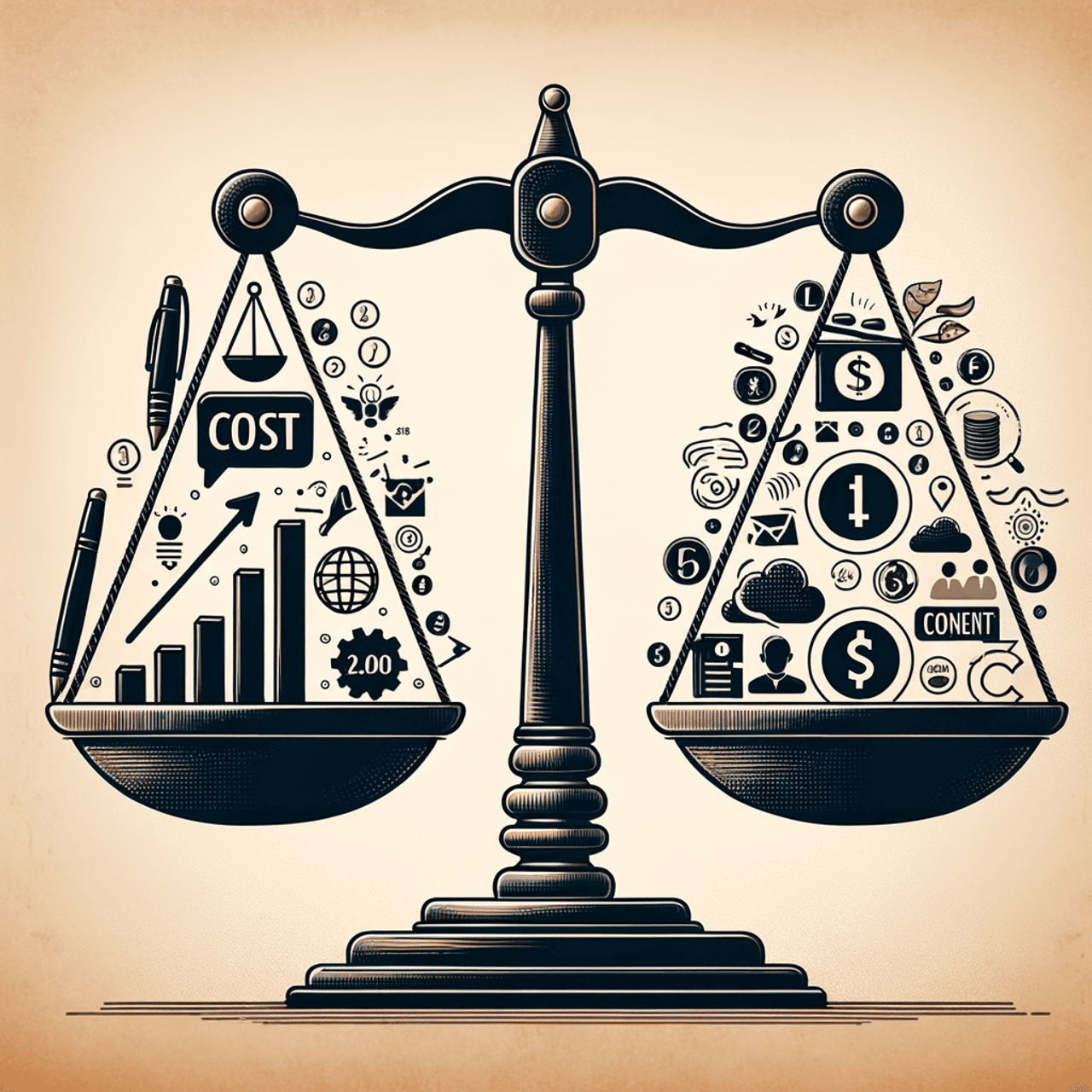 Consider the case of a small e-commerce company that was struggling to justify its content budget. With limited resources, the team needed to ensure that every dollar spent on content would deliver results. With the support of ContentERP’s centralized platform, the company increased its reach across multiple channels, ensuring that every piece of content was not only produced efficiently but also distributed to the right audiences at the right time. The platform’s advanced tools allowed the team to collaborate effortlessly, track progress in real-time, and make data-driven adjustments, ultimately leading to higher engagement rates and improved content ROI.
Consider the case of a small e-commerce company that was struggling to justify its content budget. With limited resources, the team needed to ensure that every dollar spent on content would deliver results. With the support of ContentERP’s centralized platform, the company increased its reach across multiple channels, ensuring that every piece of content was not only produced efficiently but also distributed to the right audiences at the right time. The platform’s advanced tools allowed the team to collaborate effortlessly, track progress in real-time, and make data-driven adjustments, ultimately leading to higher engagement rates and improved content ROI.
By optimizing content performance and simplifying workflows, the company transformed its content strategy into a powerhouse for driving business success. Using the platform’s analytics tools, the team identified that their audience was most engaged with blog posts that included listicles, news, and case studies. They then doubled down on this format, producing more content, which resulted in a 300% increase in lead generation and a threefold increase in content ROI. The ROI meaning shifted from mere cost recovery to a critical driver of business growth.
The Future of Content: Why ContentERP is the Key to Long-Term Success
In an age where content is king but attention spans are fleeting, businesses need more than good content to succeed—they need the right tools to measure and maximize its impact. With ContentERP, businesses can navigate the complex landscape of content marketing with confidence, knowing that every piece of content is working as hard as possible to deliver results.
By combining efficient team management, streamlined content creation, effortless promotion, seamless publishing, and content optimization in a single, user-friendly platform, ContentERP allows businesses to not only create good content but ensure it drives the kind of return on investment that justifies further investment.
Conclusion: The Power of Measurement
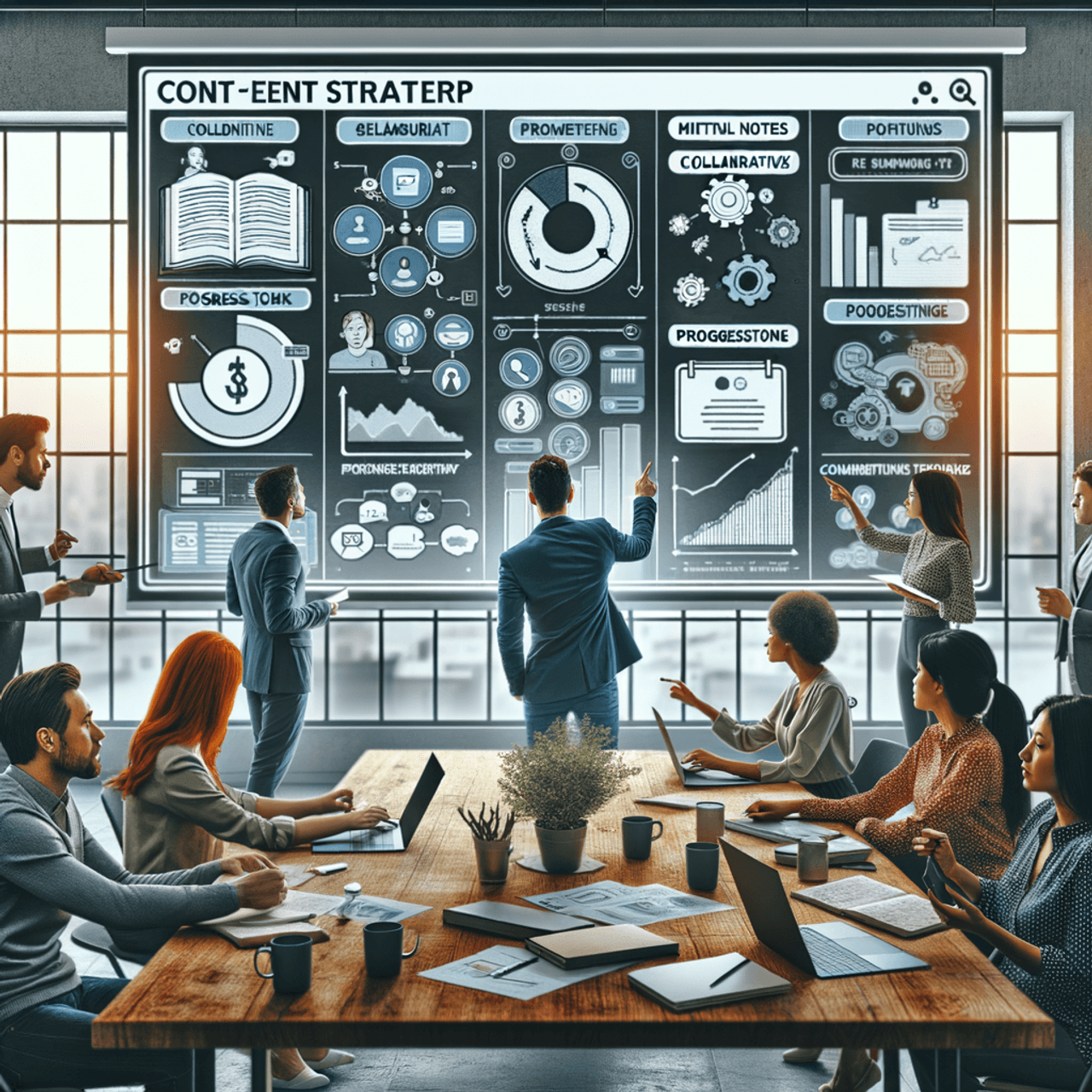 As the saying goes, “You can’t improve what you don’t measure.” In the world of content marketing, this is more than just a proverb—it’s a guiding principle. With the powerful analytics tools offered by ContentERP, businesses no longer have to rely on guesswork. They can track their content’s performance in real-time, optimize it for maximum impact, and ensure that every piece of content contributes to their bottom line.
As the saying goes, “You can’t improve what you don’t measure.” In the world of content marketing, this is more than just a proverb—it’s a guiding principle. With the powerful analytics tools offered by ContentERP, businesses no longer have to rely on guesswork. They can track their content’s performance in real-time, optimize it for maximum impact, and ensure that every piece of content contributes to their bottom line.
Take the story of a tech startup that, after months of creating content without clear direction, decided to invest in a comprehensive content strategy. By using ContentERP to manage content and tweak their approach, they were able to turn their content from an expense into one of their most significant revenue drivers—proving that, with the right tools, content ROI is not just a goal, but a reality.
In the end, successful content marketing is less about volume and more about precision. As businesses continue to face growing demands for quality content, those equipped with the right tools—like ContentERP—will be the ones to thrive in an increasingly competitive landscape.
Related: Link-Building 101: The Foundation for Powerful SEO Results
by ContentERP | Oct 13, 2024 | Uncategorized
Streamline Your Team’s Workflow With ContentERP: The Benefits of a Centralized Content Platform
 In the fast-paced world of digital content creation, keeping everything on track can sometimes feel like herding cats. Meetings overlap, emails pile up, and before you know it, half your team is chasing down the latest draft of an article while the other half is trying to remember which version of the product video they approved. It’s a scenario that’s all too familiar in most modern workplaces.
In the fast-paced world of digital content creation, keeping everything on track can sometimes feel like herding cats. Meetings overlap, emails pile up, and before you know it, half your team is chasing down the latest draft of an article while the other half is trying to remember which version of the product video they approved. It’s a scenario that’s all too familiar in most modern workplaces.
Let’s imagine a real-life scenario to paint the picture. A mid-sized marketing agency was once run like a jigsaw puzzle with pieces spread across the room. Jessica, the content manager, was constantly scrambling between emails, shared drives, and chat applications just to gather the information needed to publish a single blog post. On more than one occasion, deadlines were missed, and opportunities slipped through the cracks. Frustration boiled over when they realized that, despite their best efforts, content management was dragging their creativity down.
Enter ContentERP, a centralized content management platform that promised to transform chaos into clarity. In no time, Jessica and her team found themselves able to do what once felt impossible: manage every piece of content with the precision and efficiency of a well-oiled machine. But how did this transformation happen, and what benefits can other teams expect from such a solution? Let’s dive into the world of centralized content management and uncover the benefits of using a platform like ContentERP.
The Power of a Centralized Content Platform
Imagine your entire team working from a single source of truth—a content hub that holds every asset, idea, and file your business creates. A centralized content platform brings everything together under one roof, acting like a conductor guiding a symphony. Without it, you might have people playing the right notes, but at the wrong time or in the wrong key.
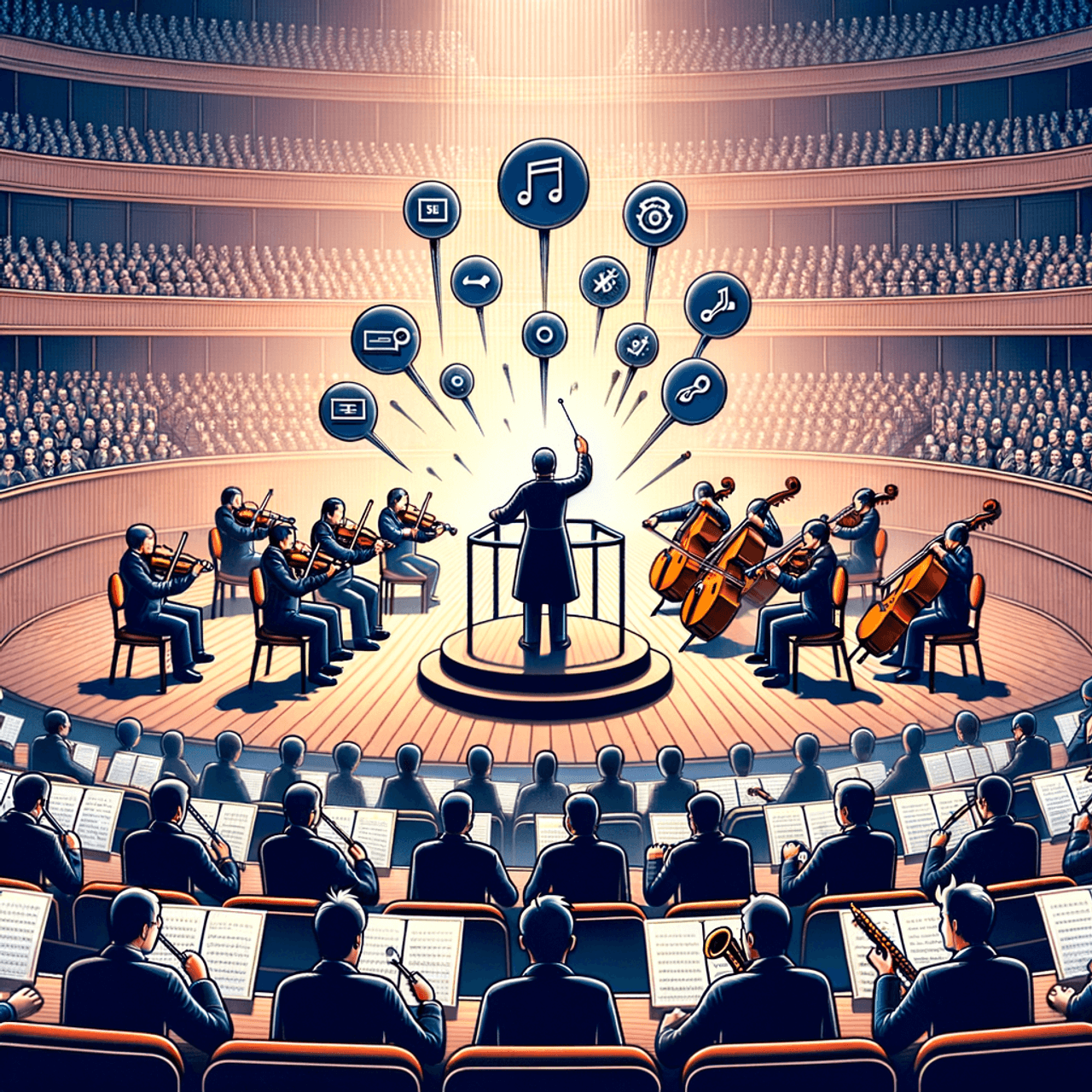 ContentERP is a prime example of this orchestration. Whether your team is spread across continents or sitting in the same office, having all your content in one place means fewer missed beats. Instead of wasting time searching through email chains, digging through folders, or asking colleagues for updates, your team can focus on what they do best—creating great content.
ContentERP is a prime example of this orchestration. Whether your team is spread across continents or sitting in the same office, having all your content in one place means fewer missed beats. Instead of wasting time searching through email chains, digging through folders, or asking colleagues for updates, your team can focus on what they do best—creating great content.
Improved Collaboration and Communication
A key feature of centralized content management systems like ContentERP is how they foster collaboration. When everyone has access to the same information, there’s no need for back-and-forth clarification. Miscommunication and version control issues, which are often the bane of content teams, become things of the past.
Take Jessica’s agency, for instance. Before ContentERP, her writers would often end up working on outdated drafts because they hadn’t received the latest update. With the platform in place, everyone now works on the same document in real-time, knowing exactly where the project stands. Communication between writers, designers, and editors is seamless, and updates are instantly reflected across the board.
Tools like task assignment, project timelines, and real-time chat within the platform further enhance communication, making sure no one is left out of the loop. This level of coordination can be the difference between hitting tight deadlines and scrambling to meet them.
Streamlined Content Workflow
Much like a river flowing smoothly toward its destination, a centralized content management system ensures that your workflow moves without obstruction. The flow of tasks, from ideation to execution, is far smoother when every step is clearly defined and all assets are easily accessible.
With ContentERP, Jessica’s team saw a drastic reduction in bottlenecks. The platform helped them build a structured workflow, complete with approval processes, content calendars, and notifications that kept everyone accountable. No more losing track of deadlines or missing approvals—everything was systematically logged and easily tracked.
Examples of Content Management Systems in Action
Several leading platforms, like ContentERP have set the standard for modern content management. For example, WordPress, which powers 43% of the web, remains a go-to content management system (CMS) for websites but lacks the full suite of content workflow tools offered by systems like ContentERP. Drupal is another open-source CMS that offers flexibility but requires technical expertise.
ContentERP sets itself apart by offering not only content storage and publishing tools but also robust workflow management features. This makes it one of the best content management systems of 2024, particularly for teams that manage a high volume of content across different formats and channels.
Related: Create Content With ContentERP
Content Creation Simplified

In the digital age, content creation is the lifeblood of businesses. From social media posts and blog articles to product descriptions and video scripts, teams are constantly creating. But creation is just the first step—the real challenge lies in managing and distributing content efficiently.
Using ContentERP’s centralized platform, Jessica’s agency could organize and categorize their content by topic, deadline, and format. This level of organization wasn’t just helpful for the team—it was essential for scaling their content production. By knowing exactly what had been created, what was in progress, and what was still needed, they could make data-driven decisions and fill content gaps efficiently.
For those just getting started in the world of content creation, content creation for beginners becomes far less intimidating with tools like ContentERP, where templates, editorial calendars, and AI-driven recommendations take the guesswork out of planning and execution.
Maximized Efficiency and Reduced Redundancies
Redundancy is a silent productivity killer. The constant re-editing of content, duplicated efforts, and poorly managed approval processes can eat away the time and energy of any team. With a content management system like ContentERP, however, these inefficiencies are kept in check.
By integrating features like automated notifications and task delegation, ContentERP ensures that every team member knows what they need to do and when. Jessica’s team saw this firsthand: content reviews became more efficient, with editors able to track revisions and feedback seamlessly. This reduced the frustrating back-and-forth of emails, which often led to confusion and missed updates.
Automation tools within the platform took it one step further by handling routine tasks, freeing up creative minds to focus on what truly matters—producing high-quality content.
A Competitive Edge: Staying Ahead With Data-Driven Decisions
Today, data is as valuable as gold, and leveraging it effectively can provide a significant advantage in any industry. ContentERP enables teams to track the performance of their content, offering detailed analytics on what works and what doesn’t.
Jessica’s team found that by using data-driven insights provided by the platform, they could optimize their content strategy in real time. From knowing which blog posts generated the most traffic to understanding audience engagement, this feedback loop allowed them to continuously improve.
Moreover, insights from the system allowed Jessica’s team to identify gaps in their content and adjust accordingly, making their overall content marketing more strategic and targeted.
One Platform, Endless Possibilities
In a world where content is king, the tools we use to manage and produce that content are just as important. With a centralized content management system like ContentERP, businesses can streamline their workflow, improve collaboration, and enhance the overall quality of their content production.
“Success favors the prepared.” With ContentERP, preparation meets precision. Teams don’t just react—they anticipate, plan, and execute seamlessly, ensuring that every project is not just completed, but completed with excellence. ContentERP isn’t just a tool; it’s the foundation for a well-oiled content operation where every step is a step toward success.
Related: Content Strategy Conferences 2024: Elevate Your Digital Marketing Game
by ContentERP | Oct 13, 2024 | Uncategorized
10 Ways to Improve Content Creation for Better SEO Rankings: Lessons from a Forgotten Garden

There once was a neglected garden in a forgotten corner of a bustling city. Overgrown with weeds and tangled vines, it had long since lost the beauty it once promised. Yet, beneath the wild growth, the soil was still rich, and hidden blooms yearned for sunlight. One day, a young gardener stumbled upon it and saw potential whereas others saw decay. With a careful plan, a steady hand, and relentless effort, she transformed the garden into a place of wonder. Visitors came from miles around to marvel at the flowers, which bloomed in vivid colors. The garden thrived, becoming the envy of the city.
The internet is much like that garden. Websites, like wild spaces, need nurturing to flourish in the dense thicket of online content. If left unchecked, they can become buried under the weight of countless others, never to see the light of high search rankings. But with the right strategies, your content can bloom, attracting more traffic, better engagement, and improved SEO rankings. Here are ten proven ways to nurture your content garden.
1. Cultivate Keywords with Care
At the heart of every well-ranked article is a careful selection of keywords. Think of these as the seeds of your content. Use a keyword rank checker to ensure you’re planting the right ones—those that are popular, relevant, and attainable. Tools like ContentERP can help streamline this process, showing you what trending searches today are ripe for the picking.
But beware of overplanting. Stuffing your content with keywords can lead to a patchy result, with poor readability and diminished trust from search engines. Instead, weave your keywords naturally into the text, like a gardener placing flowers where they’ll grow best—balanced, harmonious, and organic.
2. Create Evergreen Content That Lasts
Just as some plants thrive year-round, evergreen content remains relevant no matter the season. While trending topics may draw short-term attention, evergreen content can sustain long-term traffic. Writing guides, how-to articles, and content that answers common questions help ensure that your work stays useful—and discoverable—long after it’s published.
Evergreen content is also easier to update. As new information emerges, you can revisit and refresh your work to keep it current. Think of it as pruning the garden to ensure your blooms remain healthy and robust over time.
3. Optimize Meta Descriptions for Extra Appeal
Your meta description is like the garden gate—a visitor’s first glimpse into what lies beyond. A well-crafted meta description invites users to click through to your page, while a dull one can turn them away.
Keep your meta descriptions short, compelling, and relevant to the search query. Use action verbs and include keywords where appropriate. Just as a gardener would place a sign describing their masterpiece, your meta description should entice readers to explore what your content has to offer.
4. Build Links Like Roots Beneath the Surface
Much like the unseen roots of a tree, internal and external links form the foundation of your content’s success. Internal links guide readers through your site, increasing engagement and reducing bounce rates. External links to authoritative sources boost your credibility, signaling to search engines that your content is well-researched and reliable.
Additionally, backlinks—when other reputable sites link to your content—are like fertilizer for your SEO rankings. They tell search engines that your site is trusted and valuable. Invest in outreach strategies create content worth linking to, and watch your roots strengthen over time.
5. Make Content Visually Engaging
A garden is not just about flowers; it’s about the overall experience. In the same way, content is not just about words—visuals play a critical role in keeping readers engaged. High-quality images, infographics, videos, and charts can break up text and make information easier to digest.
Remember that visuals need to be optimized as well. Use descriptive file names and alt text to help search engines understand the content of your images. This is like adding a map of your garden to guide visitors, ensuring they see every beautiful corner.
6. Focus on Readability Like a Perfect Pathway
Your content should flow naturally, like a well-planned garden path that guides visitors from one point to the next. Break up long paragraphs, use bullet points, and employ subheadings to make your content easy to scan. Readers often skim before they commit, and if your content feels too dense or unstructured, they’ll click away before they’ve even begun.
Readability also impacts SEO. Search engines favor content that’s user-friendly and easy to understand. Tools like ContentERP can help ensure your content is structured effectively, leading to both happier readers and better rankings.
7. Regularly Prune and Refresh Old Content
Just as even the most beautiful garden needs regular maintenance, your content needs periodic updates. Search engines love fresh content, and revisiting old posts to update information, fix broken links, or improve readability can give your rankings a significant boost.
Tools like a keyword rank checker can help you identify which pieces of content are underperforming and need attention. Refreshing content also signals to search engines that your site is active and evolving, which can further improve your SEO.
8. Use Trending Topics Strategically
While evergreen content is essential, don’t ignore trending searches today. Capitalizing on trending topics can help drive immediate traffic, positioning your content as timely and relevant. Use tools like ContentERP to identify what’s hot in your industry, but remember to balance these with your long-term content strategy.
Jumping on trends without a clear plan is like planting seasonal flowers in the wrong climate—they may bloom for a short while, but they won’t last.
9. Optimize for Voice Search
As more people use voice assistants like Siri and Alexa, optimizing for voice search has become critical. Voice queries tend to be longer and more conversational, so adjust your content accordingly. Use natural language, and consider including questions and answers within your text.
Think of voice search optimization as opening new gates to your garden, welcoming visitors who may not have found you through traditional methods.
10. Speed and Mobile Optimization: The Fast Lane to Success
Just as a beautiful garden loses its charm if visitors must wade through mud to get there, slow-loading websites can frustrate users and hurt your rankings. Optimize your site for speed, especially on mobile devices, where a growing number of searches occur. Compress images, minimize code, and ensure your site is responsive.
Google’s algorithm rewards speed and mobile-friendliness. Like a well-paved path in a garden, a fast, mobile-optimized site makes it easier for visitors to explore.

The Tale of the Two Seeds
Once upon a time, two seeds were planted in the same garden. One seed sprouted quickly and grew tall, but without deep roots, it toppled in the first storm. The second seed grew slowly, sinking deep roots before stretching upward toward the sun. When the storms came, it stood strong, its foundation secure. Over time, it flourished, its leaves reaching higher than all others, admired by all who passed.
Content creation for SEO is much like planting those seeds. Quick gains from trending topics or keyword stuffing might seem appealing, but they rarely stand the test of time. Instead, it’s the steady cultivation of high-quality, well-researched, and thoughtfully optimized content that builds strong foundations and yields lasting success.
So, the next time you sit down to create content, ask yourself: Are you planting shallow seeds for fleeting attention, or are you cultivating deep roots for sustained growth? After all, the internet is a vast garden, and only the most carefully nurtured content will continue to bloom.
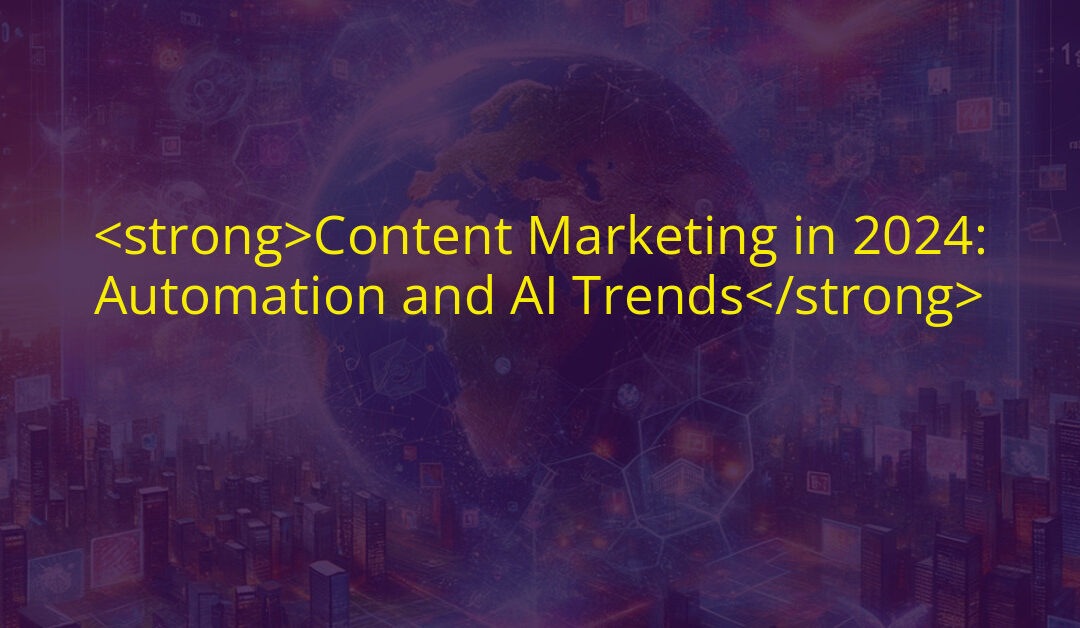
by ContentERP | Oct 13, 2024 | Uncategorized
Content Marketing in 2024: Automation and AI Trends
It was a quiet Tuesday morning when the robots arrived. Not in some grand, apocalyptic invasion, but in the form of auto-generated emails, social media posts, and blog content. Steve, the head of marketing at a mid-sized tech company, had set his content scheduler months ago, trusting that everything would run smoothly while he enjoyed his morning coffee. Yet, as he casually browsed through his company’s latest output, he realized something was wrong. The blog headline, “How to Improve Your Soup in 2024,” didn’t exactly align with his company’s core mission of cloud infrastructure solutions.
“Great,” Steve muttered under his breath. “The AI thinks we sell broth now.”
While this may sound like a far-fetched scene from a futuristic comedy, it’s a snapshot of the delicate dance between automation and human oversight in the world of content marketing. As we look ahead to 2024, automation and AI are set to dominate the landscape. But what’s more important is learning how to wield these tools effectively, ensuring that the robots work for us, not against us. Welcome to the world of content marketing in 2024—a world where automation isn’t just a buzzword but the key to staying relevant.
The Rise of AI in Content Creation: More Than Just Buzzwords
AI isn’t a new player in the game, but its presence is now felt everywhere. From generating content to analyzing consumer behavior, AI tools have evolved to the point where they are an essential part of any content marketer’s toolkit. Platforms like ContentERP have emerged, allowing businesses to streamline the content creation process, automate distribution, and even offer personalized suggestions based on real-time data. It’s like having a tireless assistant who never needs a coffee break and still manages to hit deadlines.
AI doesn’t just write—it’s analyzing search trends, predicting the success of headlines, and offering suggestions for types of content marketing that would resonate most with a target audience. The days when a marketer would sit down and think, “What should I write about today?” are quickly fading. Now, algorithms are doing much of the heavy lifting, predicting what will perform well, based on data from Content Marketing World 2024 and other industry trends.
Still, relying on AI without human touch is like baking a cake without tasting the batter. Sure, it might rise, but will it taste good?

The Types of Content Marketing AI Does Best
While AI can churn out content faster than most human marketers can type, it excels in certain types of content marketing. Here are a few areas where AI has found its sweet spot:
-
Data-Driven Reports and Case Studies
AI thrives on numbers and data, so it’s no surprise that it’s particularly adept at creating reports and case studies based on massive datasets. It can analyze consumer behavior, trends, and performance metrics to produce polished, professional reports that give businesses actionable insights.
-
Social Media Content
We’ve all seen those eerily accurate suggestions for Instagram captions or Twitter posts. AI tools now tailor social media content with a level of precision that few human marketers can match, optimizing timing, hashtags, and even tone based on audience engagement.
-
Product Descriptions and FAQs
Repetitive content, such as product descriptions and FAQs, is AI’s bread and butter. It can generate thousands of unique, SEO-optimized descriptions at lightning speed, freeing up marketers to focus on more strategic tasks. But as Steve’s soup incident reminds us, it’s always a good idea to double-check what the bots come up with.
-
Personalized Email Campaigns
AI-driven email marketing has gotten smarter. By analyzing user behavior, preferences, and previous interactions, AI can craft highly personalized email campaigns that hit just the right notes. It’s like having a crystal ball that knows what your customers want before they even do.
How Automation is Changing the Content Creation Process
In 2024, automation isn’t just about scheduling posts. It’s transforming the entire content creation process, from ideation to distribution. Automated tools, like ContentERP, now allow marketers to plan, create, and distribute content across multiple platforms seamlessly. But while automation is a gift, it also comes with a learning curve.
Marketers need to balance efficiency with creativity. Automated tools can analyze trending searches today, track SEO performance, and even suggest improvements, but they don’t replace the human touch. Content is still storytelling, and storytelling needs a soul. Otherwise, we risk a future where every blog sounds like it’s written by the same robotic hand—monotonous, predictable, and devoid of personality.
Automation works best when used as an enhancement, not a replacement. It’s like a sous-chef in the kitchen, handling the chopping, measuring, and prepping, but leaving the creativity of the dish to the chef.
The Personalization Paradox: How AI Makes Content Personal
One of the biggest trends in content marketing today is personalization. Ironically, it’s AI—the most impersonal of technologies—that’s helping marketers create highly personalized content at scale. By analyzing data points like browsing habits, previous purchases, and social media interactions, AI tools can tailor content to individual users with remarkable precision.
Think of it this way: AI is like a digital gardener, planting seeds of content based on what it knows will grow best for each visitor. It’s why you might get a personalized product recommendation email moments after visiting an e-commerce site. Or why the content on your favorite blog seems tailor-made for your interests. It’s content creation with a hyper-focus on the individual, and it’s changing the game.
But as marketers embrace AI-driven personalization, there’s a caveat: balance. Over-personalization can feel intrusive, much like a waiter who knows your order before you sit down. There’s a fine line between providing a tailored experience and making users feel like they’re being watched.

The Ethical Considerations of AI-Driven Content
As AI becomes more integral to content marketing, ethical questions start to surface. Who owns the content generated by AI? How do we ensure that automated systems don’t spread misinformation or create biased content? These are questions the marketing world is only beginning to grapple with.
In 2024, marketers must navigate this new terrain with caution. Trust is a precious commodity, and losing it can happen in an instant. Marketers must ensure that AI-generated content is factual, fair, and free from bias. It’s like building a house of cards—one wrong move and the whole structure comes crashing down.
Looking Ahead: What’s Next for Content Marketing in 2024?
As we move deeper into 2024, one thing is clear: automation and AI aren’t going anywhere. In fact, they’re only going to get more advanced, more integrated, and more essential. But amidst all this innovation, marketers must remember the fundamentals. Good content still needs to engage, entertain, and inspire. Automation can handle the grunt work, but it’s the human touch that will set brands apart.
Will we one day see an entirely AI-run content marketing industry? Possibly. But even in that future, there will always be a place for creativity, intuition, and humor—the things that make us, well, human.
A Paradox for the Ages
In the fast-paced world of content marketing, where AI and automation dominate, we find ourselves asking a curious question: If a robot writes a blog post and no one reads it, does it still rank on Google? It’s a riddle fit for the digital age—a playful reminder that even as we rely more on machines, the essence of great content is connection. Whether it’s a witty tweet, an insightful article, or a product description that hits all the right notes, the goal remains the same: creating content that resonates, regardless of who—or what—creates it.
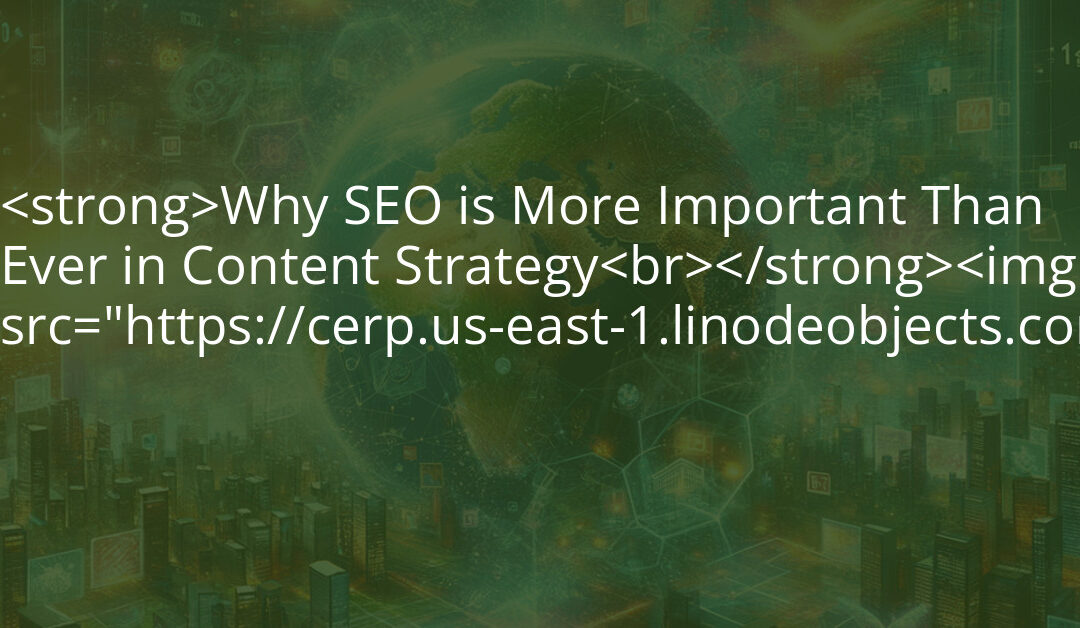
by ContentERP | Oct 13, 2024 | Uncategorized
Why SEO is More Important Than Ever in Content Strategy

“The early bird catches the worm, but it’s the search-optimized bird that gets the feast.”
In today’s fast-evolving digital landscape, this saying couldn’t be truer. While the world of search engine optimization (SEO) may once have seemed like the equivalent of a few tactical tweaks—stuffing keywords into articles, and polishing a few backlinks—today, SEO is a cornerstone of any successful content strategy. In fact, without it, even the most well-written content is like a needle buried deep in an ever-expanding haystack. As the internet grows, so do the opportunities and challenges for businesses trying to get noticed. This is where SEO steps in as the knight in shining armor. But it’s more than just about getting noticed; it’s about getting noticed by the right people at the right time, ensuring that your content is not just relevant but resonant.
The Evolution of Content Strategy and SEO
In the early days of the internet, merely having a website felt like winning a marathon—any online presence was better than none. Fast forward to the modern era, and digital marketing is a different beast entirely. Content marketing and SEO have evolved in tandem, blending like two rivers converging into one powerful force.
Content is no longer static. It’s interactive, dynamic, and multifaceted. Today’s savvy internet users expect more than just a blog post or web page. They want comprehensive guides, how-to videos, infographics, podcasts, and more. SEO is the guiding compass that ensures all of this content, in its various forms, actually reaches its audience.
In this landscape, tools like ContentERP and SEO Optimizer have become indispensable for businesses looking to stay ahead. These technologies do more than organize your content—they structure it in ways that align with SEO best practices, ensuring your message isn’t lost in the vast wilderness of search engines.
Just as SEO has evolved, so have search engines themselves. Google, of course, is still the reigning monarch of search, but competitors like Bing are making waves with their advanced algorithms and tools like Bing Analytics, which provide deeper insights into content performance. SEO is no longer just about keywords and links. It’s about understanding your audience, delivering high-quality content, and constantly optimizing for new opportunities.
SEO and Audience Understanding: A Symphony of Data and Creativity
Imagine this: SEO is the architect, and content is the building material. Without careful planning, even the most beautiful bricks and beams won’t stand the test of time. SEO ensures that the foundation of your content strategy is sound and designed for longevity.
Search engines have grown far more intelligent in how they rank content. They can now discern not only the relevance of a page based on keywords but also the depth, quality, and usefulness of the content itself. This means that churning out articles stuffed with keywords no longer suffice; rather, content creators must focus on creating value. However, creating valuable content without understanding the audience is like fishing without a rod—futile and frustrating.
This is where SEO shines. With the help of SEO tools, marketers can dive deep into the behavior of their audience. Using Bing Analytics, for example, you can analyze search patterns, bounce rates, and session durations. These metrics provide a clear picture of what your audience values and how they interact with your content. This data-driven insight is the key to producing content that resonates with readers and converts them into loyal customers.
SEO is, in this sense, the bridge between data and creativity. It allows marketers to take raw, unfiltered data and transform it into actionable insights, ensuring that their content is not just read but cherished, shared, and acted upon.

A Delicate Dance with Algorithms
SEO marketing is often compared to a game of chess. Each move must be calculated, anticipating how the search engine algorithms will respond. Like a chess player, SEO marketers must always think several steps ahead.
Google and Bing’s algorithms are constantly evolving, with updates that keep marketers on their toes. Whether it’s a shift in mobile-first indexing or an adjustment to how user experience is measured, SEO professionals must remain vigilant. These updates are like tidal waves; fail to anticipate them, and your rankings could be swept away in an instant.
While some may see this constant flux as a source of stress, it’s also an opportunity. SEO is not static, and neither is content. As algorithms become smarter, the role of SEO optimizer tools becomes even more important. These tools monitor changes, recommend adjustments, and help marketers pivot their strategies in real-time.
In this dance with algorithms, there’s a distinct harmony that comes into play. It’s the art of balancing technical precision with creative storytelling. SEO marketing is as much about pleasing robots as it is about captivating humans. This balance requires constant learning, experimenting, and refining—traits that separate the good from the great in digital marketing.
Beyond the Numbers: SEO as a Relationship Builder
While it’s easy to get lost in metrics—click-through rates, page views, and domain authority—it’s crucial to remember that at its core, SEO is about relationships. It’s not just a numbers game but a trust game. When users trust your content, search engines do, too.
Content creators often personify search engines, likening them to the gatekeepers of information. But search engines don’t just let anyone through the gates—they reward websites that have demonstrated credibility and authority over time. Think of SEO as the meticulous butler who prepares a house for guests. It ensures that everything is in place, from a clean layout to fast load times, making your site the ideal host.
Yet, just as any strong relationship takes time to build, so does SEO success. It’s not a sprint but a marathon. Quick wins are nice, but long-term strategies yield enduring success. By continually delivering value to your audience, you’re building a trust bond that not only boosts rankings but fosters customer loyalty.
SEO Tools: The Hidden Gem of Content Strategy

Behind every successful SEO campaign is a robust set of tools. Tools like ContentERP are crucial for managing the overwhelming task of content organization. With more content channels and formats to manage than ever before, content management systems that integrate SEO considerations are no longer a luxury but a necessity.
These tools streamline the process of creating and distributing content. SEO optimizers ensure that your articles are structured in ways that are both appealing to search engines and user-friendly. From optimizing title tags to ensuring internal links are strategically placed, these tools take the guesswork out of SEO.
It’s worth noting, too, that Bing Analytics offers valuable insights for marketers who want to see beyond the Google ecosystem. As Bing continues to grow, it’s becoming an important player in the search world, offering unique opportunities to tap into different audience segments.
The Road Ahead: Why SEO is the Future
The importance of SEO in content strategy isn’t just a trend; it’s the future. As the internet expands and competition grows fiercer, businesses need to invest more time and resources into SEO if they want to stay relevant.
Content creation without an SEO strategy is like trying to plant a garden without sunlight. You can water it all you want, but it will never thrive. SEO is the sunlight that helps your content bloom. The digital world is constantly shifting, and as new technologies and platforms emerge, SEO will continue to adapt. But at its core, SEO will always be about one thing: ensuring that valuable content finds its audience.
As the wise saying goes, “Good things come to those who wait.” With SEO, patience truly is a virtue. Success doesn’t happen overnight, but with the right strategy, tools, and execution, your content will rise above the noise and flourish in ways you never imagined.
In the words of Seth Godin, one of the world’s foremost marketing experts: “Content marketing is all the marketing that’s left.” Combine that with a killer SEO strategy, and your business won’t just survive—it will thrive in the digital age.

by ContentERP | Oct 13, 2024 | Uncategorized
How to Integrate Keyword Research into Your Content Strategy
Imagine walking into a crowded room full of people talking at once. Each voice is competing for attention, but only a few are heard above the noise. This is the modern digital landscape, where over 600 million blogs and countless websites are all vying for the same thing—attention. But how do you ensure that your content cuts through the clutter? How can you make sure that what you publish isn’t just another drop in the vast ocean of the internet?

The answer lies in the power of keyword research. By seamlessly integrating well-researched keywords into your content strategy, you can elevate your content from being lost in the crowd to being right in front of your audience. It’s not just about SEO or search engine rankings; it’s about delivering the right message to the right people at the right time. This article will guide you on how to weave keyword research into the very fabric of your content strategy to ensure quality, relevance, and discoverability.
Step 1: Understand the Role of Keywords in Content Strategy
Keywords are the building blocks of effective content. Think of them as the compass that guides you to your audience. Without them, you’re navigating in the dark. They provide insight into what people are searching for, what problems they’re trying to solve, and the kind of information they need. By focusing your content around the right keywords, you’re answering the very questions your audience is asking.
But here’s the catch: simply stuffing your content with random keywords isn’t enough. Google’s algorithms are too smart for that. Keyword integration must be thoughtful and strategic. It’s about creating valuable, informative content that naturally incorporates the terms your target audience is searching for.
Enter ContentERP, a comprehensive platform designed to streamline your content creation process, including keyword research. With tools like a keyword search tool and keyword surfer, ContentERP helps you identify relevant, high-traffic keywords that can give your content the visibility it deserves.
Step 2: Start with Keyword Research
The first step in integrating keyword research into your content strategy is to conduct thorough research. You need to know what your audience is searching for before you can create content that serves their needs. Several tools can help with this.
For instance, the keyword surfer and keyword planner are essential tools that provide insights into keyword search volume, competition, and related terms. These tools can also highlight the kinds of queries people are typing into search engines, giving you a treasure trove of potential topics.
But don’t just stop at finding high-volume keywords. Go deeper. Look for long-tail keywords—phrases that are more specific but often less competitive. While a keyword like “marketing tips” might be saturated, a long-tail keyword like “content marketing tips for small businesses in 2024” is more targeted, and more likely to attract the audience you’re looking for.
With ContentERP’s integrated keyword search tool, you can streamline this process. Instead of juggling multiple platforms, ContentERP brings all your keyword research needs into one dashboard, allowing you to effortlessly gather data and make informed decisions on what keywords to target.
Step 3: Map Keywords to the Content Funnel
Once you have your keywords, it’s time to map them to your content funnel. Every piece of content should be strategically placed within your buyer’s journey, from awareness to consideration to decision. Not every keyword will serve every stage, so it’s important to assign them appropriately.
For example, broad informational keywords might be ideal for top-of-funnel content, where you’re trying to raise awareness. At this stage, you’re answering general questions like “What is content marketing?” Keywords that target more specific problems, like “best content marketing strategies for e-commerce,” can serve middle-of-the-funnel content where you’re trying to engage and nurture leads.
Lastly, bottom-of-funnel content should target keywords that suggest purchase intent, like “best content management platforms” or “sign up for ContentERP.” These keywords indicate that the user is ready to take action and needs a solution—this is your opportunity to convert.
By organizing your keywords across the different stages of the buyer’s journey, you create a natural flow of information that keeps readers engaged and leads them down the path to conversion.

Step 4: Create High-Quality Content Around Your Keywords
Keyword research is important, but at the end of the day, it’s the content itself that will determine whether users stay on your page or bounce away. Keywords should be woven naturally into your content, not forced into every sentence. Think of keywords as seasoning: they enhance the dish, but too much can ruin the flavor.
With the keywords in hand, it’s time to focus on creating high-quality content that delivers real value to your audience. This is where ContentERP can be your secret weapon. Using ContentERP’s intuitive interface, you can outline, draft, and edit your content while simultaneously tracking your keyword usage, ensuring you maintain a balance between optimization and readability.
When crafting your content, keep the reader’s experience in mind. Use clear, concise language, incorporate engaging headlines, and break your content into easily digestible sections. Visual aids like images, infographics, and videos can also enhance the reading experience and make your content more shareable on social media.
Step 5: Continuously Monitor and Optimize
The world of SEO is constantly changing, and so should your content strategy. The keywords that worked yesterday might not be as effective today. This is why it’s crucial to continuously monitor the performance of your content and adjust your keyword strategy accordingly.
Using ContentERP’s advanced analytics tools, you can track how your content is performing in real-time. Are certain keywords driving more traffic than others? Is one blog post outperforming another? ContentERP can provide you with insights and recommendations for optimizing your content to improve performance over time.
In this way, keyword research isn’t a one-and-done process—it’s an ongoing effort. By regularly revisiting your keyword strategy and updating your content, you can stay ahead of the competition and continue to meet the evolving needs of your audience.
Ready to Elevate Your Content Strategy?
In the end, integrating keyword research into your content strategy is much like creating a recipe for success. You need the right ingredients (keywords), the right tools (ContentERP), and the right execution (high-quality content) to deliver something that stands out in the digital landscape.
As the digital world continues to grow more competitive, the brands and businesses that will succeed are those that know how to speak directly to their audience. And that’s exactly what effective keyword research allows you to do.
Picture this: You’re standing at the top of a mountain, having just conquered the trail. You breathe in deeply, the air crisp and cool, the view expansive. That’s what it feels like when your content is found by the right audience—rewarding, satisfying, and full of potential.
So, are you ready to take your content strategy to new heights? Sign up for ContentERP today and discover how easy it is to create content that not only resonates but also ranks.
 What is Content ROI and Why Does It Matter?
What is Content ROI and Why Does It Matter?Consider the case of a small e-commerce company that was struggling to justify its content budget. With limited resources, the team needed to ensure that every dollar spent on content would deliver results. With the support of ContentERP’s centralized platform, the company increased its reach across multiple channels, ensuring that every piece of content was not only produced efficiently but also distributed to the right audiences at the right time. The platform’s advanced tools allowed the team to collaborate effortlessly, track progress in real-time, and make data-driven adjustments, ultimately leading to higher engagement rates and improved content ROI.
As the saying goes, “You can’t improve what you don’t measure.” In the world of content marketing, this is more than just a proverb—it’s a guiding principle. With the powerful analytics tools offered by ContentERP, businesses no longer have to rely on guesswork. They can track their content’s performance in real-time, optimize it for maximum impact, and ensure that every piece of content contributes to their bottom line.



